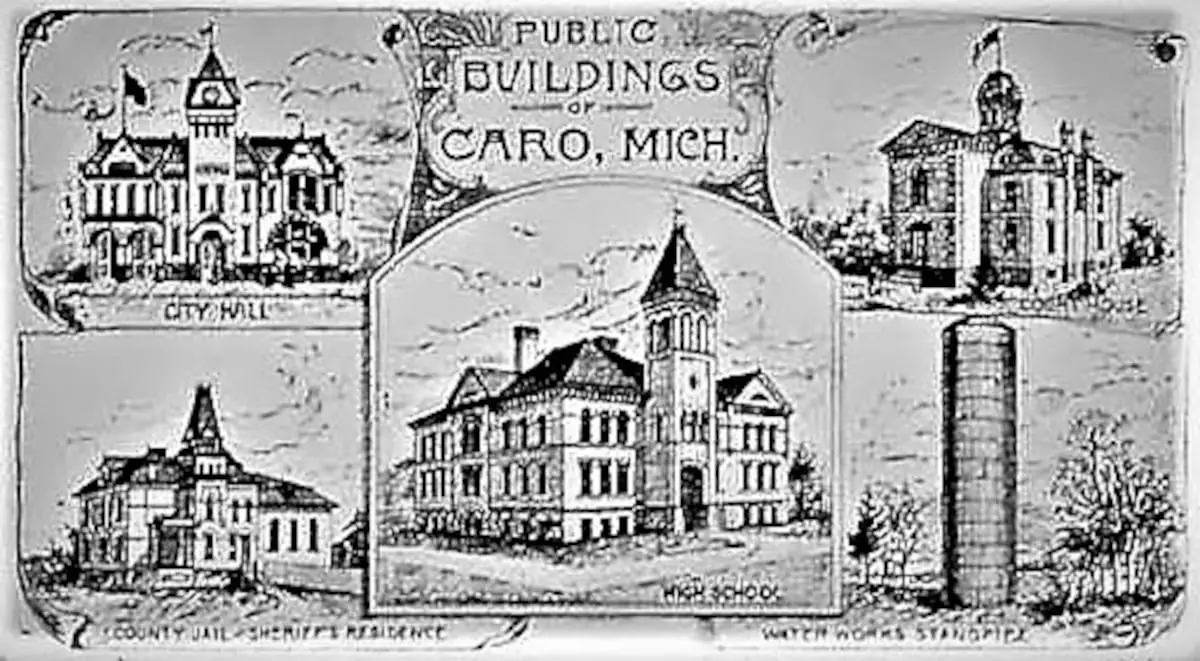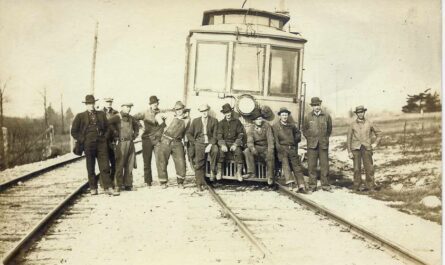By Mark Putnam
Caro’s First Public Water System
In May of 1887, the Caro community voted on its first public water system. It would be built by a private company and be called the Caro Water Works.
It would solve many more than just one problem.
First, whether to have waterworks had to come before the Caro voters.
In describing this ballot issue, the waterworks project was advertised in the local paper as the best opportunity to provide safety and comfort for Caro property owners.
Caro would in having a water system make its residents feel safe when going to bed at night against the loss and damage due to fires.
Likewise, the water system would provide the luxury and convenience of always having ready an abundant supply of pure water for drinking, cooking, and washing, for sprinkling lawns and dusty streets, and for a hundred other uses.
It was a well-known fact then to everyone that not one of the ten Caro wells that furnished water was fit for domestic uses.
To the individuals who owned these wells, they had many annoyances and expenses.
Caro Fires & Insurance
Considerable Caro property was lost in the previous three years to 1887 due to fires.
Those losses over that time amounted to several thousand dollars.
Those losses would have been prevented had a water system been in place in the community.
To fight fires, Caro had used a hand-pumped fire engine, a thousand feet of hose, and a few private cisterns.
Within two hours of pumping, the water in even the largest of water tanks or cisterns often was soon exhausted.
The firemen would get tired of working the hand-engine and filling buckets on the bucket line as they took their turns.
In dry times, the village was at even, much, more mercy.
Before 1887 was out, the new $15,000 Caro Union School and the $7,000 City Hall would be completed.
Many businesspeople stood ready to adorn Caro’s downtown streets with costly buildings at the time if they were assured that their possessions may not be swept away in an hour by fire.
Outside capital often turned its attention to Caro as a favorable location in which to invest, but they asked, “Have you a waterworks.”
Also, insurance companies discriminated against places that lacked public waterworks.
Fortuitously, at this time, it was being projected that the savings in insurance premiums would much more than pay for a new and modern, water system . . . lower rates would more than pay the cost.
Pure Water

Likewise, from impure water, currently, the health of families was imperiled.
The health risk to Caro residents and visitors for not having wholesome waterworks was much more than any potential monetary cost.
At this time, many places in the State of Michigan had a public water system.
What was Needed in the Caro Water Works?
To accomplish the construction of a Caro Water Works, a few things were needed to be solved and worked out in this infrastructure problem:
First—A well of pure water needed to be drilled into the ground.
Second—Two powerful pumps, one in reserve, were needed to be capable of pumping 40 gallons of water per day for each person using the water system.
Third—Large distribution mains or pipes that would conduct the water to all parts of the village were needed to be put underground.
Fourth—Hydrants were needed that had two or three couplings so multiple hoses could be attached; that in general would be at street corners, which would allow protection from 500 to 1,000 feet; that would throw water streams longer than steam or hand-pumped fire engine, and that could be used for many hours.
Fifth—Smaller pipes that extended from the main pipe also were needed that would supply each building with water for such things as drinking, cooking, and bathing; for toilet, lawn, and barn; and for even street fountains.
Smaller pipes also would feed steam boilers, run small water motors, and have many other uses.
Sixth—Pumps were needed that would pump water directly into the city pipelines, or a standpipe was needed that would produce pressure and be used as an elevated reservoir.
The structure that would be decided for Caro was a direct line along with a standpipe located at the “hill-top,” that would be used as the elevated reservoir.
Voters, had questions such as “Will the village flood? Caro has no sewers!”
The answer was “No.”
The answer also was that “Sewers were projected to soon follow.”
The Holly Company proposed to provide for Caro a complete system with 30 hydrants at a total annual rental of $1,500.
The initial proposed contract was for 30 years, but the Village Council would negotiate for a buyout in 10 years.
Two public “watering troughs,” also, at each end of State Street in the village would be constructed.
The Caro Village Council did not want to go into the project hastily, and after the passage of the ballot issue, it also wanted to advertise the proposal and have the contract go to the lowest bidder.
The bid eventually would go to the Holly Company, however.
Do the Mathematics

The value of Caro then was said to be much more than $500,000.
Using $500,000, though, a person whose property was valued at $1,000 would pay 1/500 of the total $1,500 rental or $3 for their water supply tax per year.
In 1887, in Caro, if a businessperson carried an insurance of $6,000 and had a building valued at $4,000, they typically would pay $75 for insurance per year.
If Caro had waterworks, that insurance would be cut in half to $37.50.
The insurance company would again lower their rate by 1/5, which would be another saving of $7.50.
The total in savings was $45.00.
The water supply tax would cost $12, so the total savings, or reduction in expenses, would be $33.00 with the completed waterworks.
Truly, the cost was not alarming.
In fact, in the end, there was a great cost-saving.
The bottom line, or net income, of this business each year would be increased by $33 due to the Caro Waterworks.
By reducing insurance payments, the water system had a positive effect on income for Caro businesses.
Homeowners also paid less for insurance.
That in a nutshell were two of the Caro Water Works’ great successes.
Insurance was not so much now a frustration or annoyance.
Construction of the Caro Water Works
(Tuscola Advertiser)
In May 1887, voters passed the Waterworks ballot issue, and the project then went on to the Caro Village Council to work out the details in the contract and in construction.
There had been a plat map of Caro at the voting hall that showed the location of the fire hydrants and other valuable information.
By August 1888, the new Caro Union School, the Tuscola Advertiser, and other buildings had Caro Water Works pipes introduced.
By September 1888, the system was tested and approved!
The Caro Water Works, or Caro Water Company, used a spring well as the source of water; it was located near the Cass River.
In the project, George W. Phelps was the contractor and company president.
C. O. Thomas was the secretary and superintendent.
Pumping went directly and up the hill to the Standpipe and had a daily capacity of 1,000,000 gallons.
The Caro Water Works Standpipe was on the ground, 85 feet, above State Street, and had a capacity of 230,000 gallons.
It was 75 feet tall and 25 feet in diameter.
The main distribution in Caro was 3 ½ miles.
The cost of the whole system was about $35,000.
In 1888, the population of Caro was about 1,800, and after the construction of the Caro Water Works, nearly all had big, cheerful, grins or smiles.
(1895 Sanborn Insurance Map of Caro, MI)
The Caro Water Works’ well and its six-foot-deep reserve reservoir were located just above the old Montague Street Bridge [today’s Chippewa Landing Bridge] that went over the Cass River.
The system’s main water pipe was 8 inches, and there were double couplet hydrants at every downtown intersection.
In 1894, a reservoir of 1,000,000 gallons was built across the Cass River and was used as a reserve supply of water.
Conclusion
It just goes to show that with a little knowledge and skill you can do great things.
In the case of the Caro Water Works, with good reasoning, it was found that the early city could build a water system in which the whole community would make a profit.
Caro Businesspeople and homeowners lowered the cost of their insurance by nearly ½ by constructing the Caro Water Works even after subtracting the water supply taxes . . . their overall net income was increased while at the same time, they had the pleasure of a system of pure and readily available water.
When a community comes together for the “greater good,” you can see a significant benefit.
The value to reduce costs of the Caro Water Works affected everyone.
Within about fifteen years, in which the early Caro Public Buildings were constructed, or between 1873 and 1888, members of the community put their hands and minds together and accomplished many great things.
Afterward, life for everyone was healthier, safer, and simply much better.
Related Reading for Caro Michigan and Caro Waterworks
The History And Story Of The Caro Michigan Dam
Caro Michigan Post Office “Mail On The Farm” Mural




